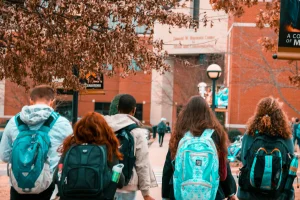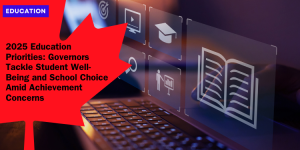Transforming Indigenous Education: $20M Investment Empowers Anishinabek First Nations Schools
Anúncios
Federal Investment Commitment
The Government of Canada and the Kinoomaadziwin Education Body (KEB) have announced a momentous investment exceeding $20 million annually dedicated to the education of Anishinabek First Nations.
This investment aims to revolutionize the educational landscape for approximately 2,000 students across participating communities by focusing on critical infrastructure upgrades and enhancements in governance structures.
Anúncios
This substantial funding is designed to support the independent self-governance and development of indigenous education systems, aligning with the broader mandate of empowering Indigenous communities to manage their educational futures.
Anúncios
The government will support educational causes
Education Infrastructure Enhancement
A critical target of the new funding initiative is to bolster educational infrastructure across Anishinabek First Nations communities.
This means ensuring that school facilities are well-equipped and conducive to learning for all students.
Improved infrastructure translates into modern classrooms, upgraded learning resources, and the establishment of technologically advanced environments that can facilitate innovative teaching methods.
By enhancing school infrastructure, the investment aims to create a robust physical foundation that is essential for the holistic development of students.
Governance Improvements
Beyond infrastructure, the investment also focuses on strengthening governance within educational institutions.
Effective governance is integral to the efficient running of schools and the sustainability of educational programs.
The funding enables the hiring of key educational personnel essential for the administration and management of Anishinabek schools.
By reinforcing the governance framework, the initiative ensures that education systems are not only accountable but also tailored to meet the specific needs of their communities.
This approach ensures that the cultural, linguistic, and academic needs of Anishinabek students are prioritized.
Direct Benefits to Anishinabek Students
The $20 million annual commitment directly benefits approximately 2,000 Anishinabek students across participating communities in Ontario.
The infusion of funds supports creating an educational environment that nurtures student success and well-being.
According to Lise Kwekkeboom, Director of Education for the Chippewas of Rama First Nation and Secretary for the KEB, “This funding is an amazing step forward in supporting communities to take control of their own education” Reader Strengthening self-governance, Anishinabek-led education.docx.
The funding allocations provide ample resources for direct student benefits, such as enhanced academic support services, extracurricular programs, and culturally relevant educational initiatives.
These measures collectively contribute to creating an inclusive and supportive educational ecosystem that celebrates Anishinabek heritage and promotes student engagement and achievement.
Commitment to Educational Excellence
The investment signifies a collaborative effort to ensure that Anishinabek students receive a world-class education that respects and reflects their cultural identity.
Honourable Gary Anandasangaree, Minister of Crown-Indigenous Relations, highlighted the significance of this initiative by stating, “All kids deserve a world-class education, and Indigenous communities know best how to deliver that for their students” Reader Strengthening self-governance, Anishinabek-led education.docx.
This initiative is a forward-looking step that underscores Canada’s commitment to aligning education policies with the United Nations Declaration on the Rights of Indigenous Peoples (UNDRIP).
These efforts affirm the right of Indigenous communities to control their education systems and ensure that the education provided is both meaningful and transformative for future generations.
The announcement of this investment represents a new chapter in the journey towards educational self-governance and improved student outcomes for Anishinabek First Nations.
As we delve deeper into the nuances of this initiative, we shall explore how it lays the groundwork for greater self-determination and cultural integration within Anishinabek educational programs.
Governance and Self-Determination
Strengthening Self-Governance
One of the most significant aspects of the recent $20 million annual funding is how it strengthens the ability of Anishinabek First Nations to govern their own education systems.
This shift towards self-governance aligns with the goals outlined in the United Nations Declaration on the Rights of Indigenous Peoples (UNDRIP) Article 14, which emphasizes the rights of Indigenous peoples to establish and control their educational systems and institutions.
By providing cutting-edge infrastructure and resources, communities can create educational environments that are nurturing and reflective of their cultural values and priorities.
This funding is more than just financial support; it represents a commitment to respect and affirm the educational authority of First Nations.
This transition not only improves educational outcomes but also fosters a sense of pride and ownership among community members.
Enabling Key Educational Positions
With the new funds, communities have the ability to hire key educational positions that are essential for the effective management and operation of their schools.
This includes roles such as curriculum developers, language and culture educators, and support staff who are critical to the administration of school programs.
By filling these positions with individuals who are closely connected to the community, the schools can ensure that the curriculum and teaching methods are culturally relevant and effective.
As Nancy O’Donnell from the Kinoomaadziwin Education Body highlights, this funding shift not only replenishes key educational roles but also allows First Nations to channel additional resources towards programs and services that offer direct benefits to Anishinabek students.
Through these strategic hires, schools can provide a more holistic and supportive environment that meets the unique needs of their students.

School is the best way to development and conection with the community
Aligning with UNDRIP Article 14
The initiative to enhance self-governance in education is firmly aligned with Canada’s efforts to adhere to the United Nations Declaration on the Rights of Indigenous Peoples, specifically Article 14.
This article asserts the right of Indigenous peoples to set up and control their educational systems in ways that reflect their culture, language, and traditional knowledge.
“Working collaboratively based on the affirmation of rights, respect, co-operation, and partnership is key to achieving reconciliation with Indigenous Peoples in Canada” (Strengthening self-governance).
Such alignment ensures that the governance practices implemented are not only effective but also respectful of Indigenous traditions and legal frameworks.
Embracing Cultural Heritage and Community Needs
By granting these communities the means to manage their education systems, schools can now seamlessly incorporate Anishinabek culture and language into everyday learning.
This culturally integrated approach fosters a deeper connection among students to their heritage and community.
Moreover, this self-governed educational model recognizes and nurtures the strengths within each community.
Instead of a one-size-fits-all curriculum, each community can tailor its educational programs to meet local needs and priorities.
This customization is critical for addressing specific challenges and harnessing unique opportunities within different First Nations.
Transitioning Towards a Brighter Future
Empowering First Nations with the control over their educational systems paves the way for long-term benefits and sustainability.
As we explore how these investments affect student success, it’s evident that embedding cultural heritage and self-determination in education lays a foundation for resilient and thriving communities.
Through these efforts, we’re not just witnessing an enhancement in educational infrastructure, but the blossoming of a partnership that truly honors and respects the rights and cultures of Indigenous peoples.
Cultural Integration and Student Success
Connecting Students to Anishinabek Culture and Language
One of the most profound aspects of the $20 million annual investment by the Government of Canada and the Kinoomaadziwin Education Body (KEB) is its focused approach on maintaining and integrating Anishinabek culture and language within the educational framework.
This initiative ensures that approximately 2,000 students across participating communities remain deeply connected to their cultural roots while receiving a quality education.
The preservation of culture and language is not just about heritage; it’s a crucial part of shaping the identity and building the confidence of young Anishinabek learners.
The funding recognizes the importance of a culturally rich curriculum that includes traditional practices, stories, and the Anishinaabemowin language.
By embedding these elements into daily learning, students gain an academic experience that is both enriching and reflective of their community’s values and wisdom.
This cultural integration helps to ground students in their identity, supporting their social and emotional well-being and fostering a sense of pride and belonging.

Integration of students is a key factor
Community Empowerment in Education Programs
Empowering local communities to tailor education programs to fit their unique needs is a central tenet of this funding initiative.
Each Anishinabek community holds its own specific traditions, experiences, and educational goals.
The flexibility offered by the funding allows schools to design and implement programs that are locally relevant, innovative, and effective.
Community-led education programs mean that students have the opportunity to learn in environments that respect and celebrate their backgrounds, further enhancing their engagement and success.
This empowerment extends to the hiring of key education positions.
With the new resources, communities can ensure that their schools are staffed with educators and administrators who not only have the necessary qualifications but also share a deep understanding and respect for Anishinabek culture.
This alignment between educational staff and community values promotes a cohesive learning atmosphere, where students feel understood and supported.
Supporting Students Across Educational Systems
The benefits of this funding are not confined to First Nation schools alone. It also supports Anishinabek students who are part of the provincial education system.
This dual support is crucial since many First Nation students attend public schools, where they might otherwise face cultural disconnects.
The investment ensures that these students still have access to initiatives that celebrate and teach their culture and language, mitigating any feelings of isolation they might experience.
By bridging the gap between First Nation and provincial schools, the funding creates a more inclusive and supportive educational landscape.
Provincial schools receiving support can collaborate with First Nations to develop programs that incorporate Indigenous perspectives, offering a more diversified and comprehensive curriculum.
This collective effort fosters a greater understanding and respect for Indigenous cultures among all students.
Looking Ahead
The integration of Anishinabek culture and language, along with the empowerment of communities to directly impact their education systems, marks a significant step towards achieving educational equity and excellence for Indigenous students in Canada.
As communities take charge and tailor their educational programs, they create an enriched learning environment that nurtures both academic and personal growth.
We transition now to exploring the broader implications of this transformative funding on the overall educational infrastructure and the future sustainability of the Anishinabek educational system.
Implementation and Reach
Serving Anishinabek First Nations
The Kinoomaadziwin Education Body (KEB) is at the forefront of this educational revolution, serving as a crucial pillar for 23 of the 39 Anishinabek First Nations in Ontario.
This initiative is part of a significant annual investment of over $20 million by the Government of Canada to improve educational infrastructure and governance within these communities.
By focusing resources on areas that matter most, from building state-of-the-art school facilities to hiring essential educational staff, KEB aims to foster an environment where approximately 2,000 Anishinabek students can thrive both academically and culturally.
Roots in Collaborative Fiscal Policy
The initiative is deeply rooted in Canada’s collaborative self-government fiscal policy established in 2019.
This policy was co-developed with First Nations partners to more accurately reflect the actual costs of self-governance, particularly in the education sector.
This approach marks a significant shift, empowering Indigenous governments to create educational systems tailored to their communities’ unique cultural and educational priorities.
This alignment with the fiscal policy ensures that the participating First Nations have the financial support they need to implement and maintain high-quality educational services that are culturally relevant and community-specific.
Education Infrastructure Enhancement
Improving educational infrastructure is a key focus of this funding.
Schools under the Anishinabek Education System (AES) are receiving the necessary upgrades to their facilities, ensuring that they are equipped to provide a world-class education that integrates Anishinabek culture and language.
With modernized classrooms, advanced technological resources, and culturally significant spaces, these schools are better suited to meet the academic and cultural needs of their students.
This holistic approach to infrastructure not only enhances the learning environment but also reinforces students’ connection to their heritage.
Boosting Student Outcomes
The ultimate goal of this investment is to boost student outcomes.
By providing funds to hire key educational positions, Anishinabek schools can support students more effectively.
These positions include teachers, cultural educators, and support staff who are crucial for delivering a balanced education that respects and incorporates Anishinabek traditions and knowledge.
Additionally, the funding allows for the development and implementation of programs tailored to the specific needs of the communities, ensuring that students receive an education that prepares them for future success while staying rooted in their cultural identity.
A Partnership for Progress
This initiative represents a meaningful partnership between the Anishinabek First Nations and the Canadian government.
By working together, they are making strides toward achieving reconciliation and respecting Indigenous rights.
The collaborative effort is a testament to the shared commitment to creating a sustainable and self-governed educational future for Anishinabek students.
Through these actions, the KEB and the Government of Canada are ensuring that Anishinabek communities have the tools and resources needed to foster educational success.
This collaboration underscores the importance of empowering Indigenous communities to take control of their educational systems, aligning with broader objectives for Indigenous rights and cultural preservation.
By focusing on these key areas of implementation and reach, the initiative lays a strong foundation for long-term progress and sustainability.
Future Impact and Sustainability
The landmark investment of over $20 million annually into the Anishinabek Education System by the Government of Canada and the Kinoomaadziwin Education Body (KEB) is set to create enduring changes for generations of Anishinabek students.
This chapter discusses the future impact and sustainability of this critical initiative aimed at improving educational outcomes and fostering self-governance for First Nations communities.
Opportunities for Anishinabek Students
The infusion of substantial funding presents a plethora of direct benefit initiatives for the roughly 2,000 Anishinabek students served by the Kinoomaadziwin Education Body.
With these resources, communities can design and implement education programs that address specific local needs and aspirations. This is particularly significant as it allows schools to:
- 👩🏫 Develop customized curricula: Tailoring educational content to include Anishinabek culture, history, and languages ensures students remain deeply connected to their heritage while receiving a comprehensive education.
- 👩🏫 Enhance learning environments: Upgraded infrastructures, from classrooms to technological resources, create a conducive learning atmosphere that meets modern educational standards.
- 👩🏫 Offer specialized support: Hiring additional staff, including counselors and tutors, helps address individual student needs, boosting overall academic performance and emotional well-being.
This targeted approach ensures that every student benefits from a nurturing and culturally resonant educational experience, paving the way for personal and academic success.
Strengthening Partnerships
The collaboration between the First Nations and Canadian government signifies a robust and evolving partnership.
This initiative is grounded in mutual respect and recognizes the importance of Indigenous self-governance. The strengthened partnership is likely to yield several long-term benefits:
- 🏫 Shared governance: Through continuous dialogue and cooperation, the Canadian government and First Nations can develop policies that reflect the needs and aspirations of Indigenous communities.
- 🏫 Resource allocation: Effective management of funds fosters transparency and accountability, ensuring that allocated resources effectively reach and benefit the intended recipients—Anishinabek students.
- 🏫 Policy evolution: Ongoing evaluations and feedback mechanisms can refine the initiative’s framework, ensuring it remains adaptive and responsive to changing educational landscapes.
By fostering a close working relationship, both parties aim to create a stable foundation for sustained educational progress and self-determination.
Long-term Self-Governance and Empowerment
The ultimate goal of this initiative is to promote long-term educational self-governance and community empowerment for the Anishinabek First Nations.
This vision aligns with Article 14 of the United Nations Declaration on the Rights of Indigenous Peoples, which emphasizes the right of Indigenous communities to establish and control their own educational systems.
- ✍️ Community-led Vision: Empowering local communities to lead their educational systems ensures that educational policies and practices are culturally relevant and effectively meet the community’s needs.
- ✍️ Sustainable Development: By focusing on long-term educational infrastructure and capacity building, the initiative creates a sustainable model that can serve future generations.
- ✍️ Cultural Preservation: Embedding Anishinabek culture and language into the education system not only preserves but also revitalizes Indigenous heritage, fostering a strong sense of identity and pride among students.
Through these efforts, the Anishinabek First Nations can achieve educational sovereignty, where communities are equipped to steer their educational futures independently and successfully.
In conclusion, the substantial investment by the Government of Canada and KEB is not just a financial boost but a comprehensive strategy to uplift the Anishinabek education system.
By creating direct benefit initiatives, strengthening partnerships, and promoting long-term self-governance and empowerment, this initiative sets the stage for transformative and sustainable educational outcomes.
Looking for news about exchange program? Check out this news.








